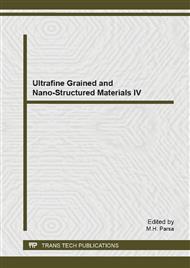p.572
p.577
p.583
p.589
p.594
p.600
p.605
p.610
p.616
Preparation and Characterization of HAp/TiO2 Nanocomposite for Photocatalytic Degradation of Methyl Orange under UV-Irradiation
Abstract:
A new in-situ precipitation technique is introduced in this study to prepare hydroxyapatite/titania nanocomposites. This technique provides a better control over the microstructures and phase compositions of nanocomposites. The structure and surface morphology of hydroxyapatite/titania nanocomposite were characterized by X-ray diffraction analysis, Fourier transform infrared spectroscopy and scanning electron microscopes. The photocatalytic activity of hydroxyapatite/titania nanocomposite was evaluated by photocatalytic decolorization of methyl orange in aqueous solution as a model pollutant under UV-irradiation. X-ray diffraction and Fourier transform infrared results indicated that hydroxyapatite and anatase (TiO2) were the major crystalline phases. There had been no reaction between hydroxyapatite and titania compounds. Based on the SEM images, the overall morphology of the samples indicates that there exists a distribution of small particles and large agglomerates.The hydroxyapatite/titania nanocomposite exhibited high photocatalytic activity hydroxyapatite/titania nanocomposite under UV-irradiation. After 8 h of irradiation by UV-irradiation, over 80% of methyl orange solution (5 mg L-1) was decolorized with 1 gL-1 of the photocatalyst. Since this process does not require the addition of hydrogen peroxide and uses UV-irradiation in this study are environmentally friendly method to decolorize azo dye.
Info:
Periodical:
Pages:
594-599
Citation:
Online since:
November 2013
Keywords:
Price:
Сopyright:
© 2014 Trans Tech Publications Ltd. All Rights Reserved
Share:
Citation:


